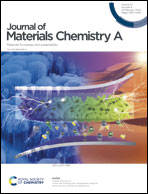In situ tailored strategy to remove capping agents from copper sulfide for building better lithium–sulfur batteries†
Abstract
Capping agents are frequently used in the chemical synthesis of materials, to precisely tailor the size, shape, and composition, with the expectation of high-performance catalysis. However, the adsorbed capping agents also serve as a physical barrier to restrict the interaction between reactants and catalytically active sites on the material surface. In this article, an in situ tailored interface strategy is introduced for effectively removing capping agents (long-chain oleylamine) from the surface of copper sulfide, to maximize the catalytic activity. The interface long-chain molecules of oleylamine are replaced by the inorganic S2− ion via a facile stirring approach without harsh processing conditions or the need for additional non-commercial materials. The as-cleaned copper sulfide shows greatly enhanced activity toward lithium–sulfur batteries, with an impressive current rate, excellent cycling stability, and great rate capability. These “clean surface” strategies using interface engineering provide a significant insight into the structure–activity relationships to support advancements in electrocatalysis technology in lithium–sulfur batteries.



 Please wait while we load your content...
Please wait while we load your content...